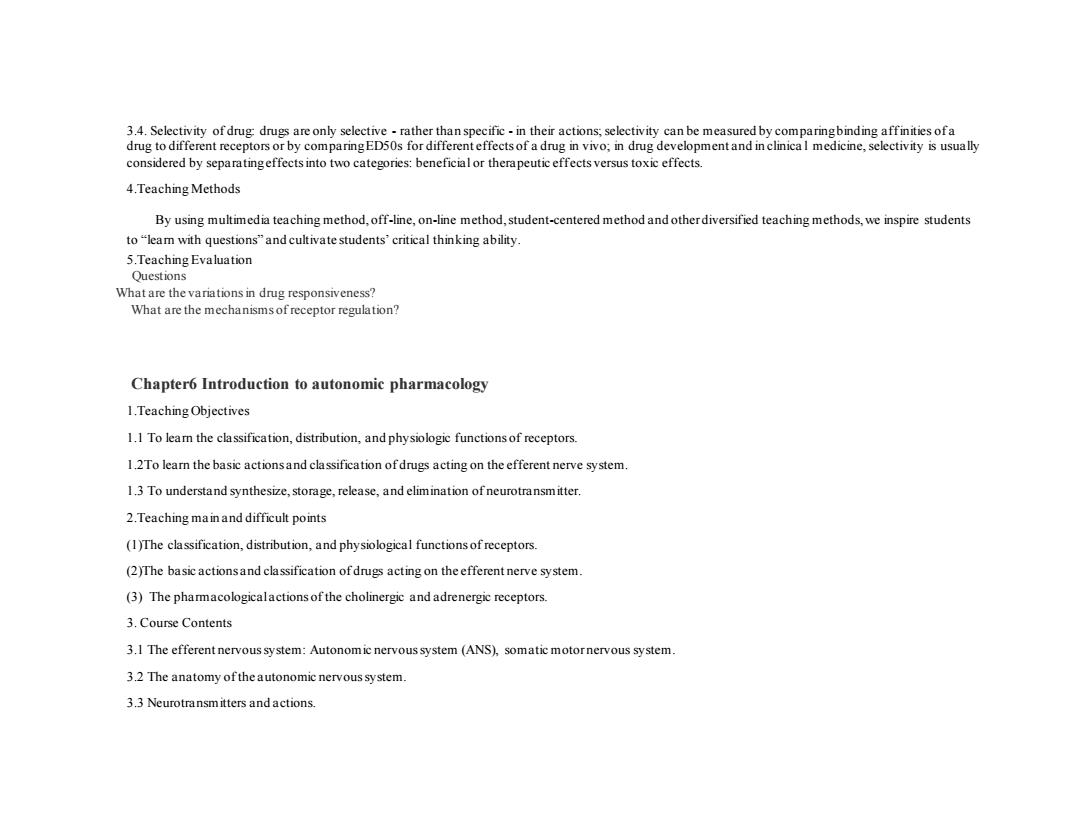正在加载图片...

3.4.Selectivity of drug drugs are only selective-rather than specific-in their actions;selectivity can be measured by comparingbinding affinities ofa drug to different receptors or by comparingED50s for different effects of a drug in vivo;in drug development and in clinica l medicine,selectivity is usually considered by separatingeffects into two categories:beneficial or therapeutic effects versus toxic effects. 4.Teaching Methods By using multimedia teaching method,off-line,on-line method,student-centered method and other diversified teaching methods,we inspire students to"leam with questions"and cultivate students'critical thinking ability. 5.Teaching Evaluation Questions What are the variations in drug responsiveness? What are the mechanisms of receptor regulation? Chapter6 Introduction to autonomic pharmacology 1.Teaching Objectives 1.1 To leam the classification,distribution,and physiologic functions of receptors. 1.2To learn the basic actionsand classification ofdrugs acting on the efferent nerve system. 1.3 To understand synthesize,storage,release,and elimination of neurotransmitter. 2.Teaching main and difficult points (1)The classification,distribution,and physiological functions ofreceptors. (2)The basic actionsand classification of drugs acting on the efferent nerve system (3)The pharmacologicalactions of the cholinergic and adrenergic receptors. 3.Course Contents 3.1 The efferent nervous system:Autonomic nervous system (ANS),somatic motornervous system. 3.2 The anatomy ofthe autonomic nervous system. 3.3 Neurotransmitters and actions.3.4. Selectivity of drug: drugs are only selective - rather than specific - in their actions; selectivity can be measured by comparing binding affinities of a drug to different receptors or by comparing ED50s for different effects of a drug in vivo; in drug development and in clinica l medicine, selectivity is usually considered by separating effects into two categories: beneficial or therapeutic eff ects versus toxic effects. 4.Teaching Methods By using multimedia teaching method, off-line, on-line method, student-centered method and other diversified teaching methods, we inspire students to “learn with questions” and cultivate students’ critical thinking ability. 5.Teaching Evaluation Questions What are the variations in drug responsiveness? What are the mechanisms of receptor regulation? Chapter6 Introduction to autonomic pharmacology 1.Teaching Objectives 1.1 To learn the classification, distribution, and physiologic functions of receptors. 1.2To learn the basic actions and classification of drugs acting on the efferent nerve system. 1.3 To understand synthesize, storage, release, and elimination of neurotransmitter. 2.Teaching main and difficult points (1)The classification, distribution, and physiological functions of receptors. (2)The basic actions and classification of drugs acting on the efferent nerve system. (3) The pharmacological actions of the cholinergic and adrenergic receptors. 3. Course Contents 3.1 The efferent nervous system: Autonomic nervous system (ANS), somatic motor nervous system. 3.2 The anatomy of the autonomic nervous system. 3.3 Neurotransmitters and actions